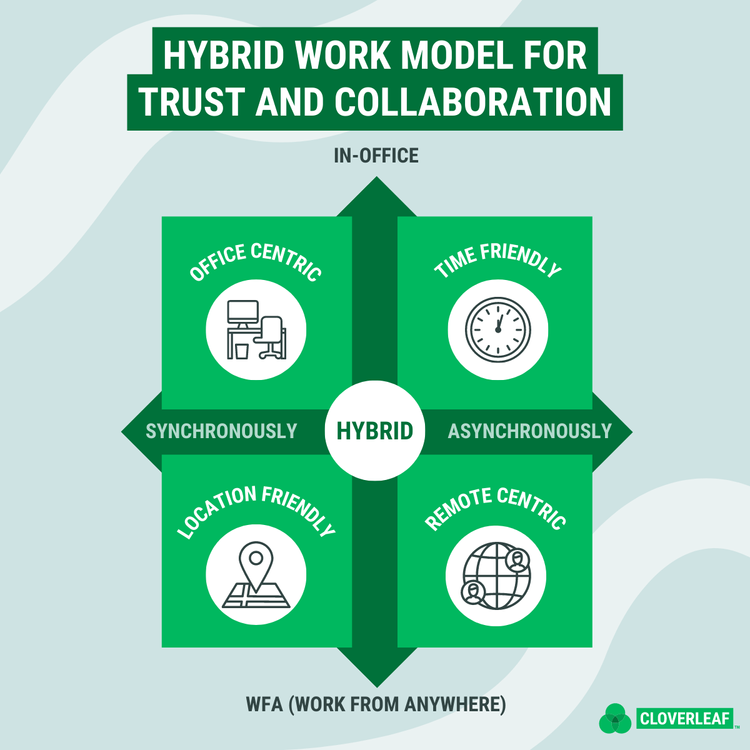The hybrid work model has become increasingly popular as it offers a unique blend of benefits, including increased engagement, autonomy, and collaboration. It represents a new work era where employees can choose where and when they work best, and organizations can foster a culture of trust, creativity, and productivity.
Although some employers may require a set number of days for hybrid employees to be in the office, a recent Gallup® poll shows that only 43% of employees reported having such a requirement.
Recently, Tuesday through Thursday appear to be the days that hybrid employees often choose to work in-office and are also the days that most employers require employees to work in-office.
Hybrid work has been around for a long time, but it’s evolved with new standards, challenges, and best practices. Companies are wisely exploring the best ways to balance in-office and remote work to meet the needs of their employees and the organization.
What Is Different About The Workplace Compared To Previous Years?
Following the COVID-19 pandemic, the work landscape experienced a transformation, with hybrid work models emerging as a new demand for employers to figure out. Below are significant factors that influence the meaning and significance of hybrid workplaces.
Rapid-Changing Technology
The widespread adoption of cloud computing, collaboration tools, and virtual communication platforms has made remote work more accessible and efficient. This has enabled organizations to adopt hybrid work models, providing employees with increased flexibility in where they work.
Changing Employees Attitude
COVID-19 accelerated the change in employees’ perspectives on work, with many now placing greater importance on work-life balance. This shift in attitudes has led to a growing demand for hybrid work arrangements.
What people are looking for isn’t flexibility of location. It’s the flexibility of time. The pandemic has shown everybody that we’re whole humans. All this hybrid talk misses the fact that it’s not the geography, the location. It’s the flexibility of being a whole human. – Marcus Buckingham
Employees care about balancing in-person and remote because it enables them to prioritize life outside work, leading to a more well-rounded and fulfilling life.
New Management Approaches
Bridging the gap between remote and in-person teams and facilitating seamless collaboration requires different thinking, new tools, streamlined processes, and transparent communication to ensure they have the resources to manage and support a hybrid workforce effectively.
Increasing Focus on Employee Wellbeing
Exploring how to motivate employees is driven by recognizing that happy and healthy employees are more productive, engaged, and likely to stay with the organization for longer.
It’s imperative for employers to understand and facilitate hybrid work models that acknowledge individuals’ humanity. If not, leaders will retain top talent and high-potential employees.

HUMAN SKILL PROGRAMS ARE HITTING LIMITATIONS...
5 THINGS THIS FREE RESOURCE WILL TEACH YOU
- Close the widening gap between learning and on-the-job application
- Overcome the tension of pausing productivity for development opportunities
- Integrate learning so it is actually in the flow of work
- The evolution of human skill development
- What Automated Coaching™ is and how it works.
Applying The Hybrid Work Model
The hybrid work model blends remote and in-person work for flexibility and better work-life balance. It is designed to accommodate flexibility within two primary dimensions; time and place, or in other words, when and where.
The Time Factor (When)
The time factor in a hybrid work model transitions employees from working synchronously with others to working asynchronously whenever they choose.
The Location Factor (Where)
This component allows employees to choose where they work. The options for a work location expand outside the office, including working from home or wherever the employee sees fit.
It’s best to envision both dimensions upon a quadrant because there is room for variation in how organizations exercise these two elements.
Office-Centric: Employees are expected to work in-office the majority of the time according to a mostly fixed schedule.
Remote-Centric: WFA is the only option for all employees and during times that are best for their schedule.
Time-Friendly: Employees can mostly choose their working hours but still require most of their time to be spent in the office.
Location-Friendly: Team members can work from anywhere but generally during the same times as others on the team.
Hybrid Work Model: A truly hybrid work model exists with fluidity for teams to shift within the quadrant according to the team and individual needs. Doing so gives team members autonomy and trust while expressing expectations for remote collaboration and teamwork.

Hybrid workers view their work as a “flow.” Hybrid workers are willing to work outside traditional work hours to balance their personal needs during the day.
As you can imagine, this flexibility is especially beneficial for individuals with unique situations, parents with children, or who prefer to manage their time and responsibilities with deeper trust.
How To Determine Which Model Is Best For Your Team
There are several questions to ask to help decide how your team can start implementing or improving your hybrid work model:
Based on the Hybrid Work Model, what extremes exist within our team, and how can we move them closer toward the center?
Which areas of our organization are suited for hybrid work?
What processes and workflows are necessary to support this environment within our organization?
What tools can we implement to support efficient, timely, and collaborative communication?
What values must our leaders adopt or model to influence supportive behavior within this environment?
Organizations can ensure that their hybrid work model is effective and sustainable in the long term by prioritizing communication and collaboration and investing in the right tools and workflows.
Adapting To A Hybrid Work Model Could Help Improve Your Culture
Hybrid work offers several advantages, such as improved work-life balance, reduced burnout, higher productivity, and less commuting time.
Hybrid work environments promote a sense of ownership and accountability among employees. With the ability to work in remote and in-person settings, employees naturally experience more autonomy and trust to manage their workloads and schedules, fostering transparency and open communication.
Additionally, the increased flexibility and focus on work-life balance can result in higher employee morale and well-being, contributing to a more positive and supportive work environment. Moreover, remote work can help reduce turnover and attract new talent who value flexibility and independence.
Adapting to remote work options is one of the strategies for increasing employee engagement. When employees can choose where and when they work, they feel more in control and can tailor their schedules to meet their personal needs. For more on this, visit the post: Creating An Employee Engagement Strategy For A Human-Centered Workplace.

Who Wants To Work From Home Or At Office Or Both?
The desire for remote work or a hybrid work model varies depending on the individual and their personal preferences, work style, and job responsibilities. Some people may prefer the structure and routine of working in an office, while others may enjoy the freedom and flexibility of working from home. Others may find that the ideal solution is a hybrid model that allows them to split their time between working from home and the office.
Many companies are now finding that not all of their employees don’t want to come back to the office; their older employees don’t want to come back to the office. Younger employees actually do because, for people in their twenties in particular, the office is a source of social connection. –Jason Feifer, entrepreneur.com
The success of remote and hybrid work models has led to a greater emphasis on results-based performance rather than the number of hours spent in the office.
It could be that people don’t want to be back in an office all day, every day. Because the problem is that nobody has thought about what happens next when somebody returns to the office. People don’t want to just be in a room. Nobody cares about that. People want connection. Maybe there’s a different way to do that. –Jason Feifer, entrepreneur.com
Clearly, the workforce desires more from their work and employer; they want meaning and fulfillment. People want their life and work to matter and to flow seamlessly together as much as possible. Hybrid work models could be a way to achieve greater levels of flexibility, collaboration, and fulfillment.
Best Practices for Hybrid Work Environments
While hybrid work models offer several benefits, they also come with their own set of challenges. Hybrid employees may face difficulties accessing work resources and equipment or experience feelings of disconnection from the company’s culture and their colleagues.
Maintaining work relationships with teammates can also be more challenging for hybrid workers, affecting team dynamics and collaboration. Additionally, it can be difficult for hybrid workers to develop their careers within an organization if there is a decrease in personal and professional familiarity with their colleagues and managers.
To overcome these challenges, companies must proactively strategize to ensure that hybrid workers fully integrate into the company culture by providing resources, tools, and support to facilitate their success.
To capitalize on the benefits of hybrid work while steering clear of the potential detriments, leaders, and employees should consider the following three suggestions.
Define Work-Home Boundaries
Working remotely can lead to increased productivity, providing best practices are implemented to set up a conducive work environment to minimize distractions.
Set boundaries with family members
Block off non-negotiable times or days to work
Create a workspace conducive to productivity
Individuals can minimize distractions and maintain focus during work by defining these boundaries and communicating them when necessary. For tips, visit the post: How to Stay Happy and Productive While Working Remotely.

Prioritize Team Building
Hybrid work arrangements can lead to less in-person interaction with teammates. This limitation is potentially problematic, affecting trust and information sharing. Therefore, it is essential to incorporate team-building activities into hybrid work environments to create opportunities for employees to interact with each other, share common interests, and build camaraderie.
Here is a list of virtual ideas to help your team get started:
Coffee breaks
Designated lunch hour where remote and in-office workers can chat over lunch in break-out rooms
Trivia
Book clubs
Fitness challenges
Happy hours
Collaborative music playlists
Designated communication channels to share non-work updates or life events
With some creativity and intentionality, hybrid teams can build strong relationships and collaborate effectively, regardless of their physical location.
Practice Consistent Communication
Virtual leadership can be complex in a hybrid work model. Regular check-ins are a great way to establish a time for communication between leaders, teams, and teammates.
Establishing a cadence for check-ins within a hybrid work model should happen in several contexts that primarily include:
All-Team (think once a quarter)
Leadership Team (think once a week)
Manager and Team Member (think once a week)
Peer To Peer: (think project-based, as frequently as necessary)
Finding a cadence to ensure productivity without micromanaging is crucial to maintaining trust. Technology like Calendar Sharing, Zoom, Slack, or 15Five facilitates efficient information sharing among team members.
Conclusion
Hybrid work models are no longer a trend but a new standard in the modern work environment. As hybrid work becomes the new standard, companies must be prepared to embrace this new way of working and create a supportive and inclusive environment for their employees. Although there are many ways teams can experiment with hybrid work, organizations must understand that a successful model requires a shift in mindset and an intentional strategy.

